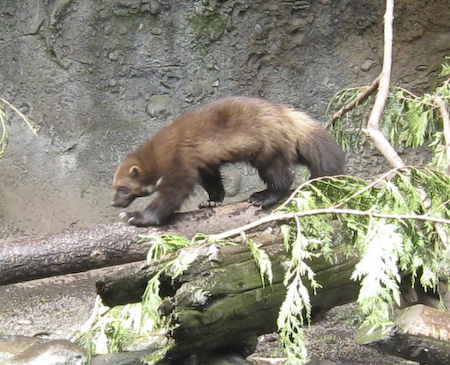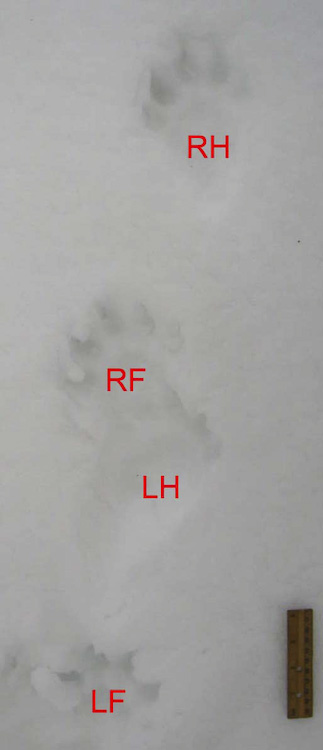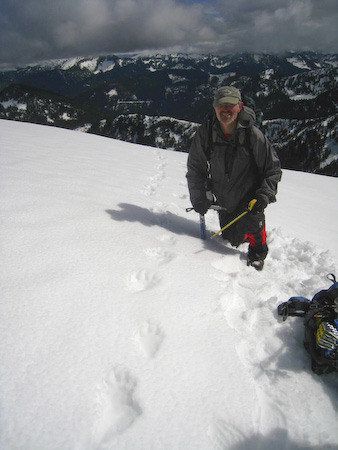 |
|
 |
|
Tracking
Quizzes
|
Quiz #50 - Answer
by Brian Booth |
 |
Photo 50J
1. The mystery animal is the mighty
WOLVERINE.
The way to figure this out is:
a) First, these
are clearly tracks from a large, powerful animal with massive claws,
high in the mountains in late winter conditions.
b) There are 5
toes on each foot – this is clear in all pictures except Photo 50I,
in which the first (inside) toe is very faint, which a common trait
of wolverine tracks. (In certain substrates, Toe 1 does not register
at all, and the tracks can look similar to a dog.)
c) A
multi-lobed, C-shaped plantar pad can be seen in the print in Photo
50E. This indicates it’s a member of the weasel family. Wolverines
are the largest of the weasels.
d) The animal switches gaits
readily, which is consistent with wolverine behavior.
e) The
tracks are similar to a black bear, but bears would not be up in the
snowy mountain summits this early in the season. Bears also do not
have C-shaped plantar pads, and generally do not travel by bounding. |
|
 |
Photo 50K
2. The uphill gait was a 2x2 bound. In
this gait the two front feet spring forward, then the hind feet land
directly on top of the front tracks (direct register). The front
tracks are obliterated, and the only tracks that can be seen are the
hind tracks.
3. The downhill gait was a 1-2-1 lope. In
this faster gait, the two front feet spring forward, then the hind
feet land forward of the front tracks (Photo 50K), so both the front
& hind tracks can be seen.
4. The wolverine was
using a bounding gait uphill to conserve energy. When going downhill
and aided by gravity it did not need to do this, and switched to its
preferred, faster and more stretched-out loping gait. |
|
This was a thrilling tracking discovery. Wolverines are extremely
rare, solitary & reclusive, and are extra difficult to find because they
prefer harsh conditions in deep wilderness at the furthest extent that
humans can travel. They are one of the most ferocious animals in North
America – in winter they can sniff out the carcass of a mountain goat
that has been killed in an avalanche, dig 15 feet deep into cement-hard
avalanche debris, and feed on the frozen carcass, bones and all, with
their powerful jaws. Moreover, it is immeasurably rare to find tracks in
such perfect snow conditions such that the plantar pads can be seen, as
wolverines’ feet are very furry in winter, which tends to make it hard
to see fine details in the prints.
This was a difficult quiz,
even if you broke out your field guides, because not many trackers
(including even some authors of field guides) are fortunate enough to
find many wolverine tracks and get familiar with them. None of my field
guides exactly matched the tracks in this quiz in size or shape, and my
field guides conflicted with each other quite a bit – enough that I had
to confer with a biologist to confirm this was really wolverine. But
despite all that, I thought it would be interesting to share. |
 |
Photo 50L shows a
happy tracker with a very satisfying discovery. (Who is that guy
anyway?)
Wishing you tracking adventures as exciting as
this one,
BRIAN
|
|
Quiz #50 - Question
...on to Quiz #51 |
| |
|
(All photos on this page are Copyright © by Brian Booth
or Walter Muma unless indicated otherwise)
To send comments, questions or feedback about these quizzes,
email me |
| |
|
Tracking Quizzes |
| |
|
|